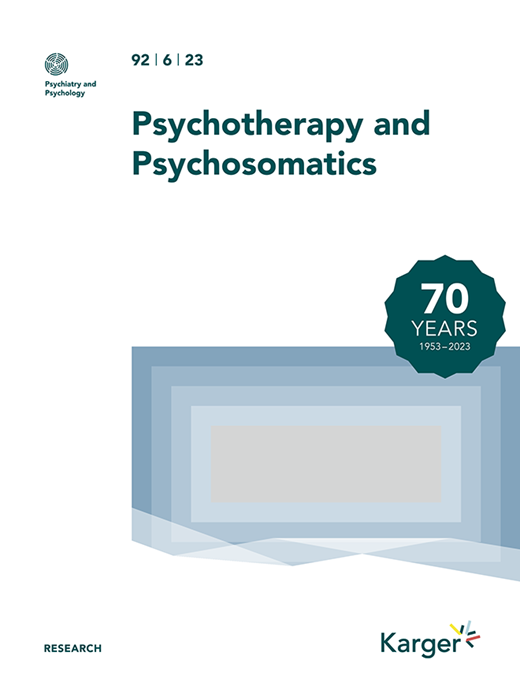Clinical and Neurophysiological Effects of Robotically-Delivered fMRI-Guided Personalized Transcranial Magnetic Stimulation Therapy for Depression.
IF 17.4
1区 医学
Q1 PSYCHIATRY
引用次数: 0
Abstract
INTRODUCTION Repetitive transcranial magnetic stimulation (rTMS) of the left dorsolateral prefrontal cortex (DLPFC) is an established treatment for refractory major depressive disorder (MDD), but treatment outcomes vary substantially from person to person. Recent evidence suggests that incorporating neuroimaging-based targeting may help improve clinical outcomes. Here, we report the initial clinical outcomes of our open-label fMRI-personalized treatment protocol from the Queensland Neurostimulation Centre (QNC). METHODS This open-label, nonrandomized study was conducted between November 2021 and September 2024. Participants were a referred sample aged between 19 and 84, meeting the criteria for treatment-resistant MDD (N=61). They received 20 or 30-weekday sessions of DLPFC rTMS. The stimulation site was personalized using each individual's fMRI brain connectivity data. RESULTS The primary outcome was change in the Montgomery-Åsberg Depression Rating Scale (MADRS). MADRS was lower post-treatment (d=1.78, p<.001), with 52% and 33% response and remission rates observed. Likewise, anxiety scores (Hamilton Anxiety Rating Scale) were lower post-treatment (d=1.27, p<.001), with 46% and 28% response and remission rates observed. The treatment was most effective in patients who qualified for randomized controlled trials (RCTs; N=19, MADRS response=74%, remission=53%) and least effective in patients with bipolar or neurological disorders (N=8, MADRS response=37%, remission=25%). Neurophysiologically, functional brain connectivity in the personalized DLPFC-SGC pathway was less anti-correlated post-treatment (d=0.63, p<.001). CONCLUSION Our findings provide new clinical and neurophysiological evidence supporting the high effectiveness of fMRI-connectivity-guided personalized rTMS for MDD, especially in individuals without complex comorbidities. The results encourage future RCTs to assess the superiority of personalized targeting over standard TMS.机器人传递fmri引导个性化经颅磁刺激治疗抑郁症的临床和神经生理效果。
重复经颅磁刺激(rTMS)左背外侧前额叶皮层(DLPFC)是治疗难治性重度抑郁症(MDD)的一种既定治疗方法,但治疗结果因人而异。最近的证据表明,结合基于神经影像学的靶向治疗可能有助于改善临床结果。在这里,我们报告了昆士兰神经刺激中心(QNC)开放标签fmri个性化治疗方案的初步临床结果。方法该开放标签、非随机研究于2021年11月至2024年9月进行。参与者是年龄在19至84岁之间的参考样本,符合治疗耐药MDD的标准(N=61)。他们接受了20或30个工作日的DLPFC rTMS治疗。使用每个人的功能磁共振成像大脑连接数据对刺激部位进行个性化处理。结果主要观察指标为Montgomery-Åsberg抑郁评定量表(MADRS)的变化。治疗后的MADRS较低(d=1.78, p< 0.001),缓解率和缓解率分别为52%和33%。同样,治疗后焦虑评分(汉密尔顿焦虑评定量表)较低(d=1.27, p< 0.001),观察到46%和28%的缓解率。在符合随机对照试验(rct;N=19, MADRS反应=74%,缓解=53%),双相或神经障碍患者效果最差(N=8, MADRS反应=37%,缓解=25%)。神经生理学上,个性化DLPFC-SGC通路的功能性脑连通性在治疗后抗相关程度较低(d=0.63, p< 0.001)。结论我们的研究结果提供了新的临床和神经生理学证据,支持fmri连接引导的个性化rTMS治疗重度抑郁症的有效性,特别是对没有复杂合并症的个体。结果鼓励未来的随机对照试验评估个性化靶向优于标准经颅磁刺激。
本文章由计算机程序翻译,如有差异,请以英文原文为准。
求助全文
约1分钟内获得全文
求助全文
来源期刊

Psychotherapy and Psychosomatics
医学-精神病学
CiteScore
29.40
自引率
6.10%
发文量
46
期刊介绍:
Psychotherapy and Psychosomatics is a reputable journal that has been published since 1953. Over the years, it has gained recognition for its independence, originality, and methodological rigor. The journal has been at the forefront of research in psychosomatic medicine, psychotherapy research, and psychopharmacology, and has contributed to the development of new lines of research in these areas. It is now ranked among the world's most cited journals in the field.
As the official journal of the International College of Psychosomatic Medicine and the World Federation for Psychotherapy, Psychotherapy and Psychosomatics serves as a platform for discussing current and controversial issues and showcasing innovations in assessment and treatment. It offers a unique forum for cutting-edge thinking at the intersection of medical and behavioral sciences, catering to both practicing clinicians and researchers.
The journal is indexed in various databases and platforms such as PubMed, MEDLINE, Web of Science, Science Citation Index, Social Sciences Citation Index, Science Citation Index Expanded, BIOSIS Previews, Google Scholar, Academic Search, and Health Research Premium Collection, among others.
 求助内容:
求助内容: 应助结果提醒方式:
应助结果提醒方式:


